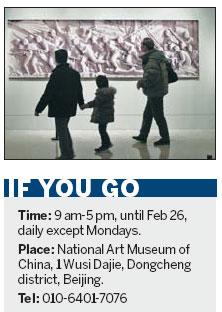The National Art Museum of China is opening up its finest treasures to the public for the first time to mark the 50th anniversary of its founding.
On display are more than 800 oils, watercolors, ink paintings, calligraphic scrolls, sculptures, prints, and folk art works, paper-cuttings, clay figurines and ethnic embroidery pieces, selected from thousands of donated works.
Highlights include The Rocks and Bamboo Scroll created by Song Dynasty official-scholar Su Shi (1037-1101), along with Sun Flowers and Wild Grass by Ming Dynasty master painter Shen Zhou (1427-1509), and A Panoramic View of the Lakes and Mountains in South China, by his contemporary Tang Yin (1470-1523), all picked from 145 works of art donated by Deng Tuo (1912-1966), former general manager and editor-in-chief of People's Daily in 1964.
The Rocks and Bamboo Scroll, 28 cm high and 105.6 cm wide, done on a piece of silk, is widely believed to be the only existing, authentic work by the Song Dynasty artist, so far found on the Chinese mainland. Another existing piece of Su's, much smaller in size, is said to be in a Japanese museum.

During the first week of the lunar new year, the exhibition attracted at least 100,000 visitors, according to museum publicist Yu Ge.
The donations by generations of Chinese art connoisseurs, artists and their families, "constitute a vital part of our permanent collection since its inception in 1961", says museum dean Fan Di'an.
Over its 50-year history, the museum has collected some 110,000 pieces of art, of which at least 10,000 items have been donated by artists and private collectors from home and abroad.
But with a floor space of only 17,000 square meters, not all of the museum's treasures can be put on permanent display, Fan notes.
An expanded National Art Museum, with a floor space of at least 90,000 sq m, is under construction in northern Beijing, near the Bird's Nest (the National Olympic Stadium).



